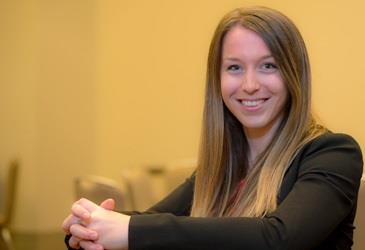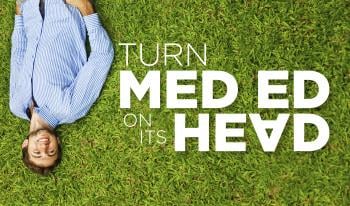Student leaders at Boston University Schools of Medicine and Public Health have devised a new way to provide health care to homeless patients in Boston and advocate on their behalf. About 7,250 men, women and children are homeless in the city. Here’s how BU’s medical students are making a big difference.
Students in the Homeless Health Care Curriculum at Boston University grasp difficult lessons in public health while advancing their knowledge of patient care, clinical skills and health disparities—all essential to the development of patient-centered physicians, said Theresa (Tess) Timmes, a third-year student at BU, who helped create the curriculum.
Timmes recently discussed the student-led program at the AMA’s CHANGEMEDED Conference. She said the curriculum started after she and her peers decided to align two student-led groups at their school. In the Outreach Van Project, medical students drive to different neighborhoods in Boston and offer basic necessities to homeless and underserved populations. They provide resources such as food, clothing, toiletries, dental supplies and basic medical care. The second group consists of students in the Homeless Health Immersion Experience, a program that allows students to conduct clinical interviews with homeless patients and volunteer at clinics.
Timmes said the two groups operated in parallel for years but never shared resources or united to help many of the same patients they’d treat on the Outreach Van Project or in clinical settings.
“We didn’t have any combined curriculum or mentorship, which really made no sense to students [because] we were working with the same [patients],” she said. “We thought, ‘There’s much more power in collaboration and combining the two programs, so with the support of our advisors at BU, that’s exactly what we did. Last year was our first year of the curriculum.”
The Homeless Health Care Curriculum launched with 56 first- and second-year students, eight student leaders and four physician mentors. Students in the program are learning how to holistically address the complex needs of homeless and underserved patients through a three-pronged curriculum.
Immersion in clinical environments that focus on the unique needs of homeless populations
“We really wanted students to interact with patients in the homeless population in two different settings,” Timmes said. Each week, students conduct the Outreach Van Project to provide resources, dental and medical care to people living on Boston’s streets. Students also participate in the Boston Homeless Health Care program, in which physicians teach students in real time how to care for homeless patients and discuss their needs.
Beyond boosting their clinical skills, this portion of the curriculum offers a crash course on effective patient communication, teaching students how to develop empathy and sincere connections with patients.
“We’re asking [students] to talk to people about some of the most vulnerable and sensitive issues in their lives, like housing stability, sexual assault on the street, whether they have food and all these other topics that are really hard to [address],” Timmes said.
A lecture series on the social determinants of health and outcomes that often affect undeserved communities
“We realized that students were interacting with these patients, but they didn’t really understand who they were—why they were homeless or the resources they don’t have—so we [hosted] lectures to explore: What is homelessness? How does one become homeless? And who is homeless?” she said. The series offers a broad-based look at the social determinants of health and the common barriers to health—both mental and physical—that physicians need to know how to address when treating homeless patients.
Community outreach
“We had students working with this patient population in a clinical and didactic setting, but we wanted students to be able to have a chance to reach out to these individuals [outside the] ‘student doctor-patient scenario,’” Timmes said. Students are participating in multiple homeless health advocacy efforts, such as Boston’s Homeless Census, food and clothing drives, and community meetings.
“This was the most meaningful part of what came out of the curriculum,” Timmes said. When an unprecedented public health crisis rocked Boston last year, Timmes and her peers were prepared to help.
On Oct. 9, 2014, 265 addiction treatment beds—more than 50 percent of the entire city’s substance use beds—and 450 shelter beds were lost as a result of the Long Island Bridge closure. Long Island is a 1.75 mile long island in the middle of Boston Harbor, and the bridge was the only way to get to it. The bridge was closed for safety concerns, and the closure left hundreds of recovering substance users—particularly those struggling with opioid addiction—without access to shelter or treatment.
BU students responded immediately. Timmes and student participants in the Homeless Health Care Program spoke out about the city-wide crisis in a perspective piece for the BU newspaper. They wrote letters to Boston’s mayor on the crisis and published an op-ed piece as a clarion call for physicians and public health officials to address those displaced by the Long Island Bridge closure.
“It was really exciting to see that in the past six months there’s been a great increase in the conversation and news coming out the mayor’s office about addressing this need, which is very important to these patients,” Timmes said.
“We unknowingly created this community of students who have these passions and put them in contact with mentors who share [them],” she said. “In doing so, that community was able to react to a real-time local crisis and develop a lot of advocacy projects. Without the curriculum there, I just don’t know if that would have been possible because before, the students weren’t even working together. So that was an accidental but very fortuitous experience to have in a learning environment.”
Have a creative idea to enhance physician training? Don’t miss this exclusive student challenge
If students were to design the med school of the future, what would it look like? How would it be structured? A new challenge with cash prizes for the best ideas gives medical students a chance to be rewarded for and to share their bold project ideas to transform physician training.
The AMA Medical Education Innovation Challenge offers a unique opportunity for educators to hear directly from students about the solutions they envision for medical education and ways to better prepare future physicians to meet the nation’s evolving health care needs. To compete in the challenge, students should form teams of two to four members. Teams must be led by a medical student (MD or DO). Other team members may be studying any discipline.
Teams should submit proposals that address one of these aspects of medical education: students, faculty, medical school infrastructure, learning environments and/or curriculum content. The submission deadline is Dec. 11.
Read more details on the challenge and learn how to submit a proposal.





